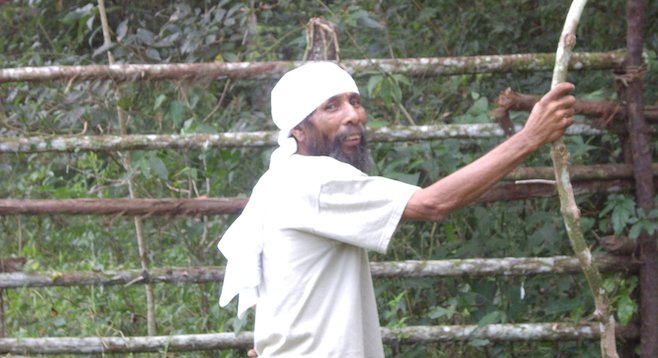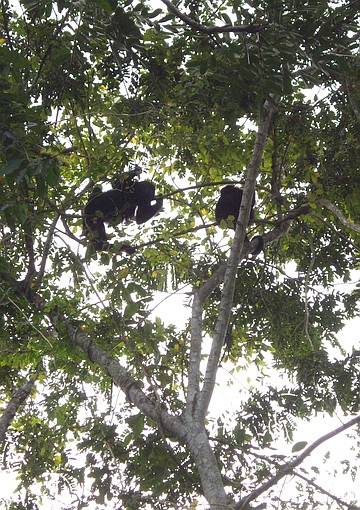 Facebook
Facebook
 X
X
 Instagram
Instagram
 TikTok
TikTok
 Youtube
Youtube

Sometimes the beauty of Central America is its simplicity.
A small sign on the west side of the road announces that you’ve arrived at the Belize Community Baboon Sanctuary. (A misnomer, Belize’s "baboons" are in reality black howler monkeys. Although I must admit I prefer the baboon moniker.)
I pulled into the lot and parked. There were two small wooden buildings. Inside one sat a young woman who appeared to be in charge, since she was the only living soul around.
When I told her I wanted to tour the sanctuary, she informed me that I could only enter with a guide. I was suspicious that she had found her mark for the day, but consented, figuring that having a guide along might add to the enjoyment as well as the possibility of successfully spotting the primates.
She told me to wait outside and someone would be with me shortly.
“Shortly” proved to be about 15 minutes. While I waited, I imagined my guide to be an enthusiastic, khaki-clad guide equipped with binoculars, a local birding publication and a wide brim hat.
What I got was Abraham.
The khaki clothing was replaced with a t-shirt and jeans, the wide brim hat gave way to a long white towel-like bandanna draped around his head, its tail trailing down his back. He held not binoculars, but a large, Moses-like walking stick. He was older, grizzled and sinewy, his weathered face completed by a flowing gray beard.
Abraham was not talkative, but pleasant and proved to have knowledge of the area. I gave him the ticket I had purchased inside and we began walking.
However, instead of entering the rainforest, he skirted the sanctuary and led me through several cultivated fields. The hike was hot, humid and uneven as we traversed farm fields and pastures.
After about a 15 to 20 minute walk he stopped at the edge of the forest. “Here,” he said. “I will call them in.”
I looked up into the tall, hardwooded mango trees and saw nothing but large waxy green leaves so filled with chlorophyll it appeared you could wring them out.

Suddenly and without warning, the guide put his hands to his mouth and let out a deep guttural growl. His calls became louder and more urgent until they were answered. First by one, then by another.
Before long the trees were infested with howler monkeys. How many were there? Ten, twenty, maybe thirty apes? It was impossible to tell.
Their voices were excited, almost frantic. The deep bravado of their calls echoed though out the otherwise quiet forest. The volume elevated to drown out Abraham, perhaps to scare the intruder away, or to answer the challenge. The back-and-forth conversation between my guide and the troop of baboons continued for around 5 full minutes. I believe it would have lasted as long as he continued to chide them.
As suddenly as he had begun, he stopped his calls. We waited for another 5-10 minutes as the howlers settled down. Their calls stopped.
The tree branches shook as they sprang from their perches into surrounding trees. Each melting into the safety of the forest, until Abraham and I were left as before, staring up into an empty mango tree.
The short hike back was uneventful, yet satisfying. I thanked Abraham and handed him a $5 tip. He asked for $5 more, which I gave to him. Maybe too much, maybe too little? He seemed happy, as was I.
Although we didn’t hike through the rainforest, the sights and sounds of Belize’s baboons offset any misgivings I had. It was truly a unique adventure and one I'd encourage others to experience.
Update: "Abraham" was in fact the late founder of Community Baboon Sanctuary, Fallet Young. He passed away from lung cancer in 2009. Along with primatologist Dr. Robert Horwhich, Fallet was instrumental in preserving forests on private land and protecting Belize's diminishing black howler monkey population through CBS. More info: howlermonkeys.org/about-the-cbs.


Sometimes the beauty of Central America is its simplicity.
A small sign on the west side of the road announces that you’ve arrived at the Belize Community Baboon Sanctuary. (A misnomer, Belize’s "baboons" are in reality black howler monkeys. Although I must admit I prefer the baboon moniker.)
I pulled into the lot and parked. There were two small wooden buildings. Inside one sat a young woman who appeared to be in charge, since she was the only living soul around.
When I told her I wanted to tour the sanctuary, she informed me that I could only enter with a guide. I was suspicious that she had found her mark for the day, but consented, figuring that having a guide along might add to the enjoyment as well as the possibility of successfully spotting the primates.
She told me to wait outside and someone would be with me shortly.
“Shortly” proved to be about 15 minutes. While I waited, I imagined my guide to be an enthusiastic, khaki-clad guide equipped with binoculars, a local birding publication and a wide brim hat.
What I got was Abraham.
The khaki clothing was replaced with a t-shirt and jeans, the wide brim hat gave way to a long white towel-like bandanna draped around his head, its tail trailing down his back. He held not binoculars, but a large, Moses-like walking stick. He was older, grizzled and sinewy, his weathered face completed by a flowing gray beard.
Abraham was not talkative, but pleasant and proved to have knowledge of the area. I gave him the ticket I had purchased inside and we began walking.
However, instead of entering the rainforest, he skirted the sanctuary and led me through several cultivated fields. The hike was hot, humid and uneven as we traversed farm fields and pastures.
After about a 15 to 20 minute walk he stopped at the edge of the forest. “Here,” he said. “I will call them in.”
I looked up into the tall, hardwooded mango trees and saw nothing but large waxy green leaves so filled with chlorophyll it appeared you could wring them out.

Suddenly and without warning, the guide put his hands to his mouth and let out a deep guttural growl. His calls became louder and more urgent until they were answered. First by one, then by another.
Before long the trees were infested with howler monkeys. How many were there? Ten, twenty, maybe thirty apes? It was impossible to tell.
Their voices were excited, almost frantic. The deep bravado of their calls echoed though out the otherwise quiet forest. The volume elevated to drown out Abraham, perhaps to scare the intruder away, or to answer the challenge. The back-and-forth conversation between my guide and the troop of baboons continued for around 5 full minutes. I believe it would have lasted as long as he continued to chide them.
As suddenly as he had begun, he stopped his calls. We waited for another 5-10 minutes as the howlers settled down. Their calls stopped.
The tree branches shook as they sprang from their perches into surrounding trees. Each melting into the safety of the forest, until Abraham and I were left as before, staring up into an empty mango tree.
The short hike back was uneventful, yet satisfying. I thanked Abraham and handed him a $5 tip. He asked for $5 more, which I gave to him. Maybe too much, maybe too little? He seemed happy, as was I.
Although we didn’t hike through the rainforest, the sights and sounds of Belize’s baboons offset any misgivings I had. It was truly a unique adventure and one I'd encourage others to experience.
Update: "Abraham" was in fact the late founder of Community Baboon Sanctuary, Fallet Young. He passed away from lung cancer in 2009. Along with primatologist Dr. Robert Horwhich, Fallet was instrumental in preserving forests on private land and protecting Belize's diminishing black howler monkey population through CBS. More info: howlermonkeys.org/about-the-cbs.
Comments